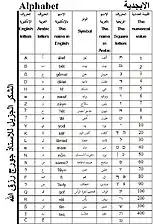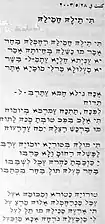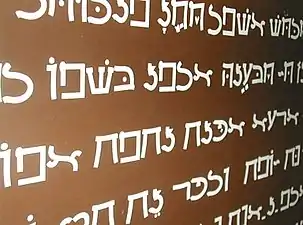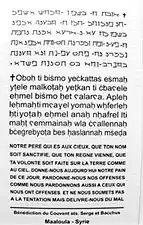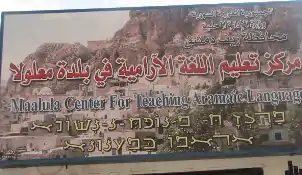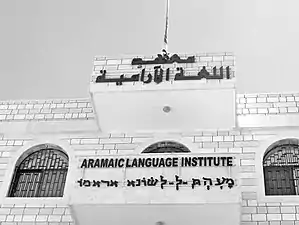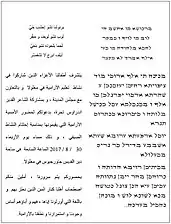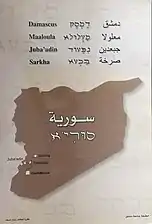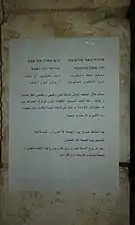Western Neo-Aramaic
Western Neo-Aramaic (liššōna arōmay), more commonly referred to as Siryon (Siryōn "Syriac"[5][6]), is a modern Western Aramaic language. Today, it is spoken by Christian and Muslim Arameans (Syriacs)[7] in only three villages – Maaloula, Bakhah, and Jubb'adin – in the Anti-Lebanon Mountains of western Syria.[8] Western Neo-Aramaic is believed to be the closest living language to the language of Jesus, whose first language, according to scholarly consensus, was Galilean Aramaic belonging to the Western branch as well; all other remaining Neo-Aramaic languages are of the Eastern branch.[9]
| Western Neo-Aramaic | |
|---|---|
| Arōmay (Siryōn) | |
| ܐܰܪܳܡܰܝ (ܣܪܝܘܢ) | |
| Pronunciation | [sirˈjo:n] |
| Native to | Syria |
| Region | Bab Touma District, Damascus; Anti-Lebanon Mountains: Maaloula, Al-Sarkha (Bakhah) and Jubb'adin. |
| Ethnicity | Aramean (Syriac)[1][2][3] |
Native speakers | 21,700 (18,800 in Syria) (2016)[4] |
Afro-Asiatic
| |
| Aramaic alphabet Latin alphabet Syriac alphabet Arabic alphabet | |
| Language codes | |
| ISO 639-3 | amw |
| Glottolog | west2763 |
| ELP | Western Neo-Aramaic |
Distribution and history
Western Neo-Aramaic is the last surviving remnant of a Western Middle Aramaic dialect which was spoken throughout the Orontes River Valley area and into the Anti-Lebanon Mountains in the 6th century. It now is spoken solely by the villagers of Maaloula, Jubb'adin and Bakh'a, about 60 kilometres (37 mi) northeast of Damascus. The continuation of this little cluster of Aramaic in a sea of Arabic is partly due to the relative isolation of the villages and their close-knit Christian and Muslim communities.
Following the Muslim conquest of the Levant, there was a linguistic shift to Arabic for local Muslims and later for remaining Christians; Arabic displaced various Aramaic languages, including Western Aramaic varieties, as the first language of the majority. Despite this, Western Aramaic appears to have survived for a relatively long time at least in some villages in mountainous areas of Lebanon and the Anti-Lebanon (in modern Syria). In fact, up until the 17th century, travellers in Lebanon still reported on several Aramaic-speaking villages.[10]
In the last three villages where the language still survives, the dialect of Bakh'a appears to be the most conservative. It has been less influenced by Arabic than the other dialects, and retains some vocabulary that is obsolete in other dialects. The dialect of Jubb'adin has changed the most. It is heavily influenced by Arabic, and has a more developed phonology. The dialect of Maaloula is somewhere between the two, but is closer to that of Jubb'adin. Cross-linguistic influence between Aramaic and Arabic has been mutual, as Syrian Arabic itself (and Levantine Arabic in general) retains an Aramaic substratum.[11] Similar to the Eastern Neo-Aramaic languages, Western Neo-Aramaic is heavily using Kurdish loanwords unlike other Western Aramaic dialects, e. g. in their negation structure:”Čū ndōmex“ meaning "I do not sleep“ in the Maalouli dialect.[12][13] These influences might indicate an older historical connection between Western Neo-Aramaic and Eastern Aramaic speakers.[14] Other strong linguistic influences on Western Neo-Aramaic include Akkadian during the Neo-Babylonian period.[15]
As in most of the Levant prior to the introduction of Islam in the seventh century, the villages were originally all Christian. However, Maaloula is the only village that retains a sizeable Christian population (they belong to the Greek Orthodox Church of Antioch and Melkite Greek Catholic Church) as most of the inhabitants of Bakh'a and Jubb Adin adopted Islam over the generations, and are now all Muslim. Maaloula glows in the pale blue wash with which houses are painted every year in honour of Mary, mother of Jesus.
Historical accounts, as documented by Parisot in 1898, suggest that the people of Maaloula and nearby areas claim to be descendants of migrants from the Sinjar region (modern Iraq). According to their oral traditions, their ancestors embarked on a substantial migration in ancient times, driven by the challenges posed by the Muslim occupation of the northern part of Mesopotamia. Seeking refuge, they crossed the Euphrates River and traversed the Palmyrene desert, eventually finding a lasting sanctuary among Western Aramaic-speaking communities in the highlands of eastern Syria.[16]
All three remaining Western Neo-Aramaic dialects are facing critical endangerment as living languages. As with any village community in the 21st century, young residents are migrating into major cities like Damascus and Aleppo in search of better employment opportunities, thus forcing them into monolingual Arabic-speaking settings, in turn straining the opportunity to actively maintain Western Neo-Aramaic as a language of daily use. Nevertheless, the Syrian government provides support for teaching the language.[17] Since 2007, Maaloula has been home to an Aramaic institute established by the Damascus University that teaches courses to keep the language alive. The institute's activities were suspended in 2010 amidst fears that the square Aramaic alphabet used in the program too closely resembled the square script of the Hebrew alphabet and all the signs with the square Aramaic script were taken down. The program stated that they would instead use the more distinct Syriac alphabet, although use of the Aramaic alphabet has continued to some degree.[18] Al Jazeera Arabic also broadcast a program about Western Neo-Aramaic and the villages in which it is spoken with the square script still in use.[19]
In December 2016 during an Aramaic Singing Festival in Maaloula, a modified version of an older style of the Aramaic alphabet closer to the Phoenician alphabet was used for Western Neo-Aramaic. This script seems to be used as a true alphabet with letters to represent both consonants and vowels instead of the traditional system of the Aramaic alphabet where it's used as an abjad. A recently published book about Maaloula Aramaic also uses this script.[20][21]
Aramaic Bible Translation has worked for over 10 years on the translation of the Bible to Suryon (Malouli Dialect) and the audio recording of Portrait of Jesus, and The Syriac language organization Rinyo has published the content made by ABT, and developed by Kanusoft.com, Book of Psalms from the Old Testament, in writing and the book Portrait of Jesus in writing with audio in Aromay (Suryon/Seryenai) in the Syriac Serto script on their website and a translation of the New Testament into Aromay has been finished in 2017 and is now available online.[22][23][24]
In July 2017 a free course in Western Neo-Aramaic started at Damascus University.[25][26][27][28]
Phonology
The phonology of Western Neo-Aramaic has developed quite differently from other Aramaic languages. The labial consonants of older Western Aramaic, /p/ and /f/, have been retained in Bakh'a and Maaloula while they have mostly collapsed to /f/ in Jubb'adin under influence from Arabic. The labial consonant pair /b~v/ has collapsed to /b/ in all three villages. Amongst dental consonants, the fricatives /θ ð/ are retained while /d/ have become /ð/ in most places and /t/, while remaining a phoneme, has had its traditional position in Aramaic words replaced by /ts/ in Bakh'a, and /tʃ/ in Maaloula and Jubb'adin. However, [ti] is the usual form for the relative particle in these two villages, with a variant [tʃi], where Bakh'a always uses [tsi]. Among the velar consonants, the traditional voiced pair of /ɡ ɣ/ has collapsed into /ɣ/, while /ɡ/ still remains a phoneme in some words. The unvoiced velar fricative, /x/, is retained, but its plosive complement /k/, while also remaining a distinct phoneme, has in its traditional positions in Aramaic words started to undergo palatalization. In Bakh'a, the palatalization is hardly apparent; in Maaloula, it is more obvious, and often leads to [kʲ]; in Jubb'adin, it has become /tʃ/, and has thus merged phonemically with the original positions of /t/. The original uvular plosive, /q/, has also moved forward in Western Neo-Aramaic. In Bakh'a it has become a strongly post-velar plosive, and in Maaloula more lightly post-velar. In Jubb'adin, however, it has replaced the velar plosive, and become /k/.
Alphabet
Square Aramaic alphabet
Square Aramaic Alphabet used for Aromay/Western Neo-Aramaic.[30] Words beginning with a vowel are written with an initial ![]() . Short vowels are omitted or written with diacritics, long vowels are transcribed with macrons (Āā, Ēē, Īī, Ōō, Ūū) and are written with mater lectionis (
. Short vowels are omitted or written with diacritics, long vowels are transcribed with macrons (Āā, Ēē, Īī, Ōō, Ūū) and are written with mater lectionis (![]() for /o/ and /u/,
for /o/ and /u/, ![]() for /i/, which are also used at the end of a word if it ends with one of these vowels and if a word begins with any of these long vowels, they begin with
for /i/, which are also used at the end of a word if it ends with one of these vowels and if a word begins with any of these long vowels, they begin with ![]() + the mater lectionis). Words ending with /a/ are written with
+ the mater lectionis). Words ending with /a/ are written with ![]() at the end of the word, while words ending with /e/ are written with
at the end of the word, while words ending with /e/ are written with ![]() at the end. Sometimes
at the end. Sometimes ![]() is used both for final
is used both for final ![]() and
and ![]() instead of also using
instead of also using ![]() .
.
| Aramaic letter | |||||||||||||||||||||||||||||
| Hebrew letter | א | בּ | ב | גּ | ג | דּ | ד | ה | ו | ז | ח | ט | י | כּ ךּ | כ ך | ל | מ ם | נ ן | ס | ע | פּ ףּ | פ ף | צ ץ | ק | ר | שׁ | תּ | ת | ת |
| Latin letter/Transliteration | Aa, Ee, Ii, Oo, Uu Āā, Ēē, Īī, Ōō, Ūū |
Bb | Vv | Gg | Ġġ | Dd | Ḏḏ | Hh | Ww | Zz | Ḥḥ | Ṭṭ | Yy | Kk | H̱ẖ | Ll | Mm | Nn | Ss | Ҁҁ | Pp | Ff | Ṣṣ | Rr | Šš | Tt | Ṯṯ | Čč | |
| Pronunciation | ∅ | /b/ | /v/ | /g/, /ʒ/ | /ɣ/ | /d/ | /ð/ | /h/ | /w/ | /z/ | /ħ/ | /tˤ/ | /j/ | /k/ | /x/ | /l/ | /m/ | /n/ | /s/ | /ʕ/ | /p/ | /f/ | /sˤ/ | /k/~/ḳ/ | /r/ | /ʃ/ | /t/ | /θ/ | /tʃ/ |
Syriac and Arabic alphabet
Serto Syriac and Arabic alphabet used for Aromay/Western Neo-Aramaic.[24]
| Syriac letter: | ܐ | ܒ | ܒ݆ | ܓ | ܔ | ܓ݂ | ܕ | ܕ݂ | ܗ | ܘ | ܙ | ܚ | ܚ݂ | ܛ | ܜ | ܝ | ܟ | ܟ݂ | ܠ | ܡ | ܢ | ܣ | ܥ | ܦ | ܨ | ܨ̇ | ܩ | ܪ | ܫ | ܬ | ܬ݂ | ܬ̤ |
| Arabic letter: | ا | ب | پ | گ | ج | غ | د | ذ | ه | و | ز | ح | خ | ط | ظ | ي | ک | خ | ل | م | ن | س | ع | ف | ص | ض | ق | ر | ش | ت | ث | چ |
| Pronunciation | /ʔ/, ∅ | /b/ | /p/ | /g/ | /dʒ/ | /ɣ/ | /d/ | /ð/ | /h/ | /w/ | /z/ | /ħ/ | /x/ | /tˤ/ | /dˤ/ | /j/ | /k/ | /x/ | /l/ | /m/ | /n/ | /s/ | /ʕ/ | /f/ | /sˤ/ | /ðˤ/ | /q/~/ḳ/ | /r/ | /ʃ/ | /t/ | /θ/ | /tʃ/ |
| Syriac letter | ܰ | ܶ | ܳ | ܺ | ܽ |
| Arabic letter | ـَ | ـِ | ـُ | ي | و |
| Pronunciation | /a/ | /e/ | /o/ | /i/ | /u/ |
Alternate Aramaic alphabet
Characters of the script system similar to the Old Aramaic/Phoenician alphabet used occasionally for Western Neo-Aramaic with matching transliteration. The script is used as a true alphabet with distinct letters for all phonemes including vowels instead of the traditional abjad system with plosive-fricative pairs.[31][21]
| Letter | ||||||||||||||||||||||||||||||
| Transliteration | b | ġ | ḏ | h | w | z | ḥ | ṭ | y | k | x | l | m | n | s | ʕ | p | f | ṣ | ḳ | r | š | t | ṯ | č | ž | ᶄ | ḏ̣ | ẓ | ' |
| Pronunciation | /b/ | /ɣ/ | /ð/ | /h/ | /w/ | /z/ | /ħ/ | /tˤ/ | /j/ | /k/ | /x/ | /l/ | /m/ | /n/ | /s/ | /ʕ/ | /p/ | /f/ | /sˤ/ | /k/~/ḳ/ | /r/ | /ʃ/ | /t/ | /θ/ | /tʃ/ | /ʒ/ | /kʲ/ | /ðˤ/ | /dˤ/ | /ʔ/ |
| Letter | |||||||||||
| Transliteration | a | ā | e | ē | i | ī | o | ō | u | ū | ᵊ |
| Pronunciation | /a/ | /a:/ | /e/ | /e:/ | /i/ | /i:/ | /o/ | /o:/ | /u/ | /u:/ | /ə/ |
Sample of Lord's Prayer
Lord's Prayer in Western Neo-Aramaic, Turoyo, Syriac and Hebrew.
| Western Neo-Aramaic | Turoyo (Central Neo-Aramaic) | Classical Syriac | Hebrew |
|---|---|---|---|
| Ōboḥ ti bišmō yičqattaš ešmaẖ | Abuna d-këtyo bišmayo miqadeš ešmoḵ | Aḇūn d-ḇa-šmayyāʾ neṯqaddaš šmāḵ | Avinu šebašamayim yitkadeš šimḵa |
| yṯēle molkaẖ yiṯkan ti čbaҁēleh | g-dëṯyo i malkuṯayḏoḵ howe u ṣebyonayḏoḵ | tēṯēʾ malkūṯāḵ nēhwēʾ ṣeḇyānāḵ | tavo malḵutḵa, ya'aseh retsonẖa |
| iẖmel bišmō ẖet ҁalarҁa. | ḵud d'kit bi šmayo hawḵa bi arҁo ste | ʾaykannāʾ d-ḇa-šmayyāʾ ʾāp̄ b-ʾarʿāʾ. | kevašamayim ken ba'arets. |
| Aplēḥ leḥmaḥ uẖẖil yōmaḥ | Haw lan u laḥmo d-sniquṯayḏan adyawma | Haḇ lan laḥmāʾ d-sūnqānan yawmānā | Et leẖem ẖukenu ten lanu hayom |
| ġfurlēḥ ḥṭiyōṯaḥ eẖmil | wa šbaq lan a-ḥṭohayḏan ḵud d-aḥna ste | wa-šḇōq lan ḥawbayn wa-ḥṭāhayn | uselaẖ lanu al ẖata'enu |
| nġofrin lti maḥiṭ ҁemmaynaḥ | sbaq lan lanek laf elan | ʾaykanāʾ d-āp̄ ḥnan šḇaqn l-ḥayāḇayn | kefi šesolẖim gam anaẖnu laẖot'im lanu |
| wlōfaš ttaẖlennaḥ bčaġribyōṯa | w lo maҁbret lan l'nesyuno | w-lāʾ taʿlan l-nesyōnāʾ | ve'al tavienu lide nisayon |
| bes ḥaslannaḥ m-šēḏa | elo mfaṣay lan mu bišo | ʾelāʾ paṣān men bīšāʾ | ki im ẖaltsenu min hara |
Miscellaneous words and sample phrases[32][33]
| English | Western Neo-Aramaic |
|---|---|
| Hello / Peace | šloma |
| Altar server | šammoša |
| Morning | ʕṣofra |
| Mountain | ṭūra |
| Water | mōya |
| God | alo, iloha |
| Sun | šimša |
| Mouth | femma |
| Head | rayša |
| Village | qrīṯa |
| I swear (by the Cross) | b'sliba |
| Nice | ḥalya |
| Here / here it is | hōxa, hōxa hū |
| Liar | daklona |
| After | bōṯar min |
| Son | ebra |
| Daughter | berča |
| Brother / Brothers | ḥōna, ḥuno |
| Sister | ḥōṯa |
| Donkey | hmora |
| Tongue / language | lišōna |
| Money | kiršo |
| Nation | omṯa |
| Year | ešna |
| Moon | ṣahra |
| King | malka |
| Earth | arʕa |
| Dove | yawna |
| Long live! | tihi! |
| Grave | qabra |
| Food | xōla |
| (Paternal) Uncle | ḏōḏa |
| (Maternal) Uncle | ḥōla |
| (Paternal) Aunt | ʕamṯa |
| (Maternal) Aunt | ḥōlča |
| Father | ōbū |
| Mother | emma |
| My mother | emmay |
| Grandfather | gitta [ʒita] |
| Grandmother | gičča [ʒitʃa] |
| Way | tarba |
| Ocean | yamma |
| Congratulations! | brixa! |
| Aramean (Syriac) | suray |
| Sky | šmoya |
| Who? | mōn? |
| Love | rhmoṯa |
| Kiss | noškṯa |
| How are you? | ex čōb? (m), ex čība? (f) |
| Fast | sawma |
| Human | barnōša |
| Holy Spirit | ruẖa qudšo |
| Poison | samma |
| Sword | seyfa |
| Bone | germa |
| Blood | eḏma |
| Half | felka |
| Skin | gelta |
| Hunger | xafna |
| Stone / rock | xefa |
| Vineyard | xarma |
| Back | hassa |
| Goat | ezza |
| Lip | sefṯa |
| Chin / beard | ḏeqna |
| Tooth / crag | šennā |
| Past | zibnō |
| Queen | malkṯa |
| The little man | ḡabrōna zʕora |
| Peace to all of you | šloma lḵulxun |
| Who is this? | mōn hanna? (m), mōn hōḏ? (f) |
| I am Aramean (Syriac) and my language is Aramaic (Syriac) | ana suray w lišoni siryon |
| We are Arameans (Syriacs) and our language is Aramaic (Syriac) | anaḥ suroy w lišonah siryon |
| Church | klēsya (Greek loanword) |
| shirt | qameṣča (from Latin camisia) |
| What's your name? (m) | mō ošmaḵ? (m) |
| Dream | helma |
| Old man | soba |
Gallery
See also
Literature
- Arnold, Werner: Das Neuwestaramäische (Western Neo-Aramaic), 5 volumes. Harrassowitz, Wiesbaden (Semitica Viva 4),
- Volume 1: Texte aus Baxʿa (Texts from Baxʿa), 1989, ISBN 3-447-02949-8,
- Volume 2: Texte aus Ğubbʿadīn (Texts from Ğubbʿadīn), 1990, ISBN 3-447-03051-8,
- Volume 3: Volkskundliche Texte aus Maʿlūla (Texts of folk tradition from Maʿlūla), 1991, ISBN 3-447-03166-2,
- Volume 4: Orale Literatur aus Maʿlūla (Oral Literature from Maʿlūla), 1991, ISBN 3-447-03173-5,
- Volume 5: Grammatik (Grammar), 1990, ISBN 3-447-03099-2/
- Arnold, Werner: Lehrbuch des Neuwestaramäischen (A Manual to Western Neo-Aramaic), Harrassowitz, Wiesbaden 1989, ISBN 3-447-02910-2.
- Wehbi, Rimon (2021). "Zwei neuwestaramäische Texte über die Wassermühlen in Maalula (Syrien)". Mediterranean Language Review. 28: 135–153. doi:10.13173/medilangrevi.28.2021.0135. S2CID 245214675.
Notes
- The Semitic Heritage of Northwest Syria, p. 271
- “…Maaloula Syriacs have maintained their Syriac identity since ancient times, and there is ample evidence of their Syriac heritage, especially in Maaloula, Ain Tineh, Bakhah, and Jubaadin…“, translated quote from the book إلياس أنطون نصر الله في معلولا, p. 45
- "Hilfe für das Aramäerdorf Maaloula e.V. | an aid project in Syria".
- Western Neo-Aramaic at Ethnologue (23rd ed., 2020)

- Western Neo-Aramaic: The Dialect of Jubaadin , p. 446
- Maaloula (XIXe-XXIe siècles). Du vieux avec du neuf, p. 95
- ”…The city of Jubaadin in Syria, which is close to Maaloula, is inhabited by Aramaic-speaking people who are Syriac Arameans…“, translated quote from the Arabic book (Atlas of Religions) معلولا السريان
- Brock, An Introduction to Syriac Studies Archived 2013-05-18 at the Wayback Machine. Retrieved July 2011
- "Easter Sunday: A Syrian bid to resurrect Aramaic, the language of Jesus Christ". Christian Science Monitor. 2010-04-02. ISSN 0882-7729. Retrieved 2022-11-07.
- Owens, Jonathan (2000). Arabic as a Minority Language. Walter de Gruyter. p. 347. ISBN 3-11-016578-3.
- Studies in the Grammar and Lexicon of Neo-Aramaic by Geoffrey Khan, Paul M. Noorlander
- Studies in the Grammar and Lexicon of Neo-Aramaic, Geoffrey Khan, Paul M. Noorlander
- Semitic Languages: Outline of a Comparative Grammar - p. 464
- Brockelmann (GVG 1 §19)
- Akkadian influences on Aramaic (Assyriological Studies) by Kaufman, Stephan A.
- Parisot (1898a: 270): "D'áprès leurs tradi-ins, jaddan San gaddin, les habitants de ce village et des lieux avoisinants raient des émigrés du pays de Sendjar. Ils disent qu'à une époque ancienne, urs ancêtres voulant se soustraire aux vexations des musulmans qui avaient ivahi la partie septentrionale de la Mésopotamie, auraient traverse l'Euphrate le désert de la Palmyrène, pour se réfugier définitivement sur les hauts ateaux de la Syrie orientale, à trois cents lieues de leur pays d'origine."
- Sabar, Ariel (18 February 2013). "How To Save A Dying Language". Ankawa. Retrieved 2 April 2013.
- Beach, Alastair (2010-04-02). "Easter Sunday: A Syrian bid to resurrect Aramaic, the language of Jesus Christ". Christian Science Monitor. Retrieved 2010-04-02.
- Archived at Ghostarchive and the Wayback Machine: "أرض تحكي لغة المسيح". YouTube.
- "Aramaic singing festival in Maaloula for preserving Aramaic language – Syrian Arab News Agency". 10 September 2016.
- Francis, Issam (10 June 2016). L'Arameen Parle A Maaloula – Issam Francis. Lulu.com. ISBN 9781365174810.
- "Ma'luli". Aramaic Bible Translation.
- "Bible - Rinyo.org". www.rinyo.org.
- https://scriptureearth.org/data/amw/PDF/amwMaLuliNT-web.pdf
- ""الآرامية" بالمجان في جامعة دمشق | الاتحاد الوطني لطلبة سورية". 18 July 2017.
- "دورة مجانية لتعليم اللغة الآرامية بجامعة دمشق".
- http://tishreenonline.sy/2017/07/17/%D8%AF%D9%88%D8%B1%D8%A9-%D9%85%D8%AC%D8%A7%D9%86%D9%8A%D8%A9-%D9%84%D8%AA%D8%B9%D9%84%D9%8A%D9%85-%D8%A7%D9%84%D9%84%D8%BA%D8%A9-%D8%A7%D9%84%D8%A2%D8%B1%D8%A7%D9%85%D9%8A%D8%A9-%D9%81%D9%8A-%D8%AC/
- "آرامي جامعة دمشق | Facebook". www.facebook.com.
- Werner, Arnold (2011). Western Neo-Aramaic. In Stefan Weninger (ed.), The Semitic Languages: An International Handbook: Berlin: De Gruyter Mouton. pp. 685–696.
- "الأبجدية المربعة | PDF".
- "襄阳阂俑装饰工程有限公司". www.aramia.net.
- Das Neuwestaramäische Wörterbuch: Neuwestaramäisch von Werner Arnold, The Western Neo-Aramaic Dictionary: Western Neo-Aramaic by Werner Arnold
- Western Neo-Aramaic Vocabulary by Lambert Jungmann
Sources
- Arnold, Werner (1990). "New materials on Western Neo-Aramaic". Studies in Neo-Aramaic. Atlanta: Scholars Press. pp. 131–149. ISBN 9781555404307.
- Arnold, Werner (2008). "The Roots qrṭ and qrṣ in Western Neo-Aramaic". Aramaic in Its Historical and Linguistic Setting. Wiesbaden: Harrassowitz Verlag. pp. 305–311. ISBN 9783447057875.
- Arnold, Werner (2012). "Western Neo-Aramaic". The Semitic Languages: An International Handbook. Berlin-Boston: Walter de Gruyter. pp. 685–696. ISBN 9783110251586.
- Beyer, Klaus (1986). The Aramaic Language: Its Distribution and Subdivisions. Göttingen: Vandenhoeck & Ruprecht. ISBN 9783525535738.
- Brock, Sebastian P. (1989). "Three Thousand Years of Aramaic Literature". ARAM Periodical. 1 (1): 11–23.
- Khan, Geoffrey (2019). "The Neo-Aramaic Dialects and Their Historical Background". The Syriac World. London: Routledge. pp. 266–289. ISBN 9781138899018.
- Kim, Ronald (2008). "Stammbaum or Continuum? The Subgrouping of Modern Aramaic Dialects Reconsidered". Journal of the American Oriental Society. 128 (3): 505–531.
- Weninger, Stefan (2012). "Aramaic-Arabic Language Contact". The Semitic Languages: An International Handbook. Berlin-Boston: Walter de Gruyter. pp. 747–755. ISBN 9783110251586.
- Yildiz, Efrem (2000). "The Aramaic Language and its Classification". Journal of Assyrian Academic Studies. 14 (1): 23–44.
External links
- Yawna – Maaloula Aramaic a non-profit educational initiative dedicated to the preservation of Aramaic – the language of Jesus – and the rich cultural heritage of Maaloula.
- Western Neo-Aramaic alphabet and pronunciation at Omniglot
- (in German) Archived 2005-12-16 at the Wayback Machine.
- The dialect of Maaloula. Grammar, vocabulary and texts. (1897–1898) By Jean Parisot (in French): Parts 1, 2, 3 at the Internet Archive.

